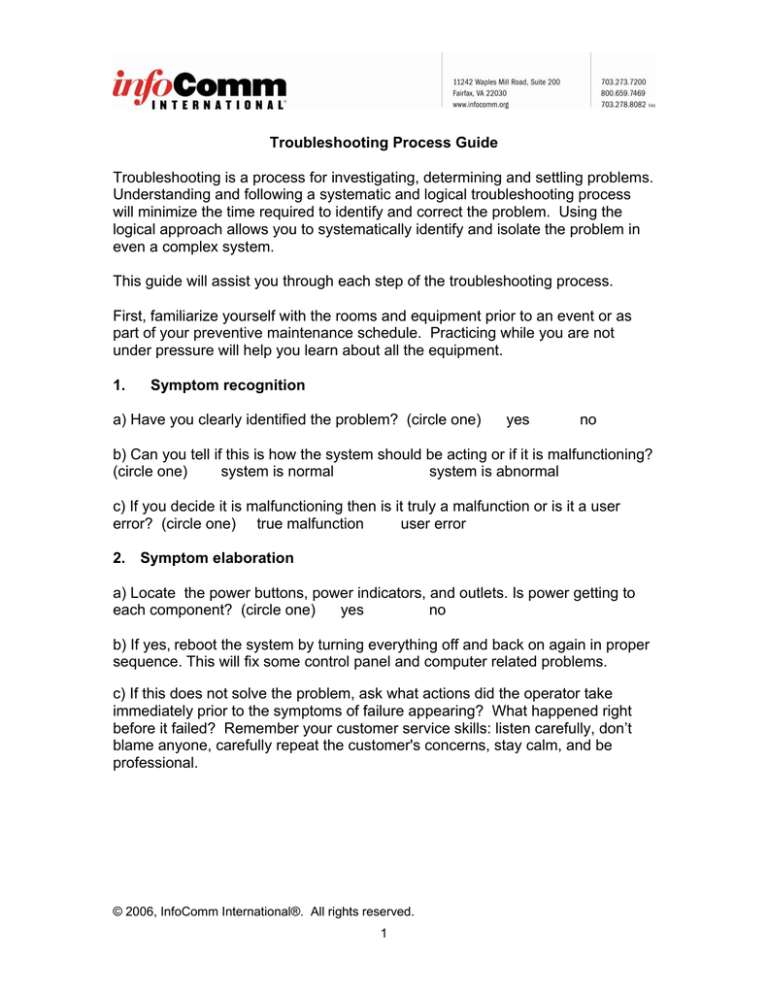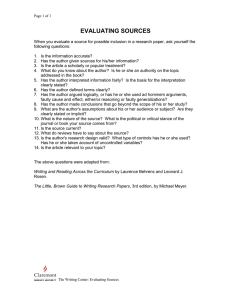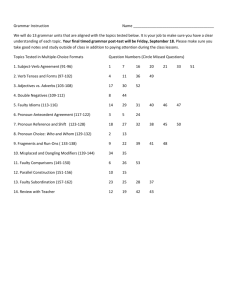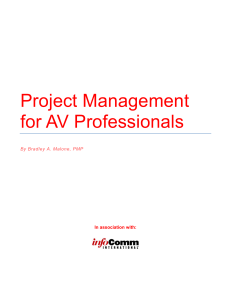Troubleshooting Process Guide Troubleshooting is a process for
advertisement

Troubleshooting Process Guide Troubleshooting is a process for investigating, determining and settling problems. Understanding and following a systematic and logical troubleshooting process will minimize the time required to identify and correct the problem. Using the logical approach allows you to systematically identify and isolate the problem in even a complex system. This guide will assist you through each step of the troubleshooting process. First, familiarize yourself with the rooms and equipment prior to an event or as part of your preventive maintenance schedule. Practicing while you are not under pressure will help you learn about all the equipment. 1. Symptom recognition a) Have you clearly identified the problem? (circle one) yes no b) Can you tell if this is how the system should be acting or if it is malfunctioning? (circle one) system is normal system is abnormal c) If you decide it is malfunctioning then is it truly a malfunction or is it a user error? (circle one) true malfunction user error 2. Symptom elaboration a) Locate the power buttons, power indicators, and outlets. Is power getting to each component? (circle one) yes no b) If yes, reboot the system by turning everything off and back on again in proper sequence. This will fix some control panel and computer related problems. c) If this does not solve the problem, ask what actions did the operator take immediately prior to the symptoms of failure appearing? What happened right before it failed? Remember your customer service skills: listen carefully, don’t blame anyone, carefully repeat the customer's concerns, stay calm, and be professional. © 2006, InfoComm International®. All rights reserved. 1 d) In the case that the problem might take longer than five minutes to solve, stop and talk to the presenter. • How long does he/she want you to work on the problem? • Estimate the amount of time it will take to fix the problem or circle “unknown” below: Time ____________ or UNKNOWN • Does the customer wish to continue without the equipment or does he or she want to take the time to allow you to repair the equipment? 3. List probable faulty functions a) First identify the major functions and sub-systems present within the system. What types of failures can occur within these functions and subsystems that will result in the identified symptoms? b) Understanding the way the system is configured, make a list below of where the problem could be occurring: • ________________________________________________________ • ________________________________________________________ • ________________________________________________________ • ________________________________________________________ c) Use this information to create a list of potential sources of the system fault. • ________________________________________________________ • ________________________________________________________ • ________________________________________________________ • ________________________________________________________ • ________________________________________________________ © 2006, InfoComm International®. All rights reserved. 2 d) Finally, create a list of the possible faulty components or functions that can be related to the symptoms. These will become the subjects of the testing process during the next step in the troubleshooting process. • _______________________________________________________ • _______________________________________________________ • _______________________________________________________ • _______________________________________________________ • _______________________________________________________ 4. Localizing the faulty function a) Test the items from your list of potentially faulty functions in order to rule out properly functioning areas and identify the faulty areas. Tests can be simple, such as checking to see if cables are connected, or more complicated, like using a multimeter to check for proper output characteristics. b) Select the specific sequence of items to test based on a number of factors. You can: • Select a function/device that will eliminate other possible faulty functions • Select a test that is easy to accomplish • Select a specific item to test based on prior experience with the specific system or component. c) If you are unable to create a detailed list of all the probable faulty functions, you can begin to analyze the system in your head. Given the symptoms, what would most likely cause the failure? d) Is it a good time to talk to the presenter? If so, tell them what you have been doing, and what you are going to do next. Ask the presenter if he or she wants to implement a back-up plan or have you continue to troubleshoot the glitch. If you cannot fix the problem within a reasonable amount of time, consider setting up a temporary portable system to accommodate immediate needs might be a suitable solution. Contact any colleagues to help you fix the problem in order to accomplish the task as efficiently as possible. © 2006, InfoComm International®. All rights reserved. 3 5. Analyze and localize the faulty function a) Continue to test in order to isolate the problem to the specific faulty component configuration point. b) While you are tracing the signal, check the connectors to make sure they are plugged in all the way. c) While checking, look for exposed wire and damaged insulation. Look for bent or broken pins on the connectors. If there is damage to any of the components, replace them. 6. Failure analysis a) Once you have determined the problem, it is then time to correct it and figure out how to prevent it from happening again. Is the problem the result of: • Inadequate training? • Improper component selection? • Inadequate preventive maintenance? • Disruption in signal flow? b) If you can’t tell what is creating the problem, try using your ears and listen to the equipment. Do you hear anything out of the ordinary such as clicks, humming or a buzz? If you hear unusual sounds from a particular component, try to replace it first. c) If the problem hasn’t been solved and you have implemented a back-up plan, follow up with your client and apologize for the inconvenience. Explain how you plan to prevent this problem from occurring in the future. Tell the client only what he or she needs to know to understand what the problem is. Assure the client that the problem will be solved as soon as possible. Ask when he or she plans to use the equipment again and make sure it is fixed before that date. d) In a situation where the service request was left unresolved, think about what you might do differently to speed up the process next time. © 2006, InfoComm International®. All rights reserved. 4 e) Ask yourself several questions: • What can you learn from the situation? • What can you do to prevent it from happening again? • When can you show the customers how the equipment works? • Can you think of ways you could be better prepared for this situation? • Do you know how the room is wired? • Are there schematics for the room so you can find out where the signal should go? • Do you have a crash kit? • Are there more items you should include in the kit next time? • Have you create a log of past problems you or others have encountered? • Is this a reoccurring problem? • What were some solutions you or others used in the past? f) Finally, speak to your colleagues in the industry to see if they have faced similar problems and how they responded. Take time to learn about the equipment. Enroll in courses, such as Essentials of the AV industry, to expand your knowledge. © 2006, InfoComm International®. All rights reserved. 5




